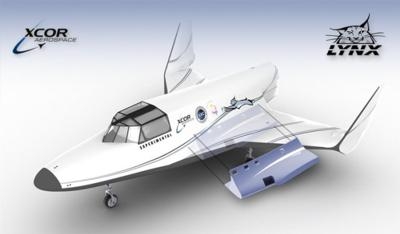Thu, Sep 13, 2012
Critical Component Designed For 'Tens Of Thousands' Of Flights
XCOR Aerospace announced Tuesday that the Lynx Mark I suborbital reusable launch vehicle (RLV) wing strake assemblies will be manufactured by FiberDyne Advanced Composites of Tukwila, WA. The Lynx wing strakes are critical structural components that attach the Lynx fuselage to the wings and hold kerosene fuel, attachment points for the main landing gear, and bays for the vehicle's reaction control thrusters.

The strakes have been designed by XCOR to rigorous design standards that will enable a craft to perform tens of thousands of flights to and from suborbital altitudes exceeding 100 kilometers. The strake has undergone an iterative design process by XCOR engineers and outside independent third party structural and thermal analysis experts from Quartus Engineering in San Diego.
FiberDyne was selected after a thorough competitive selection process that emphasized past experience, ability to manufacture complex carbon fiber structures used in safety critical pressurized applications, schedule and value. FiberDyne is teamed with tool maker Sierra Technical Services of Mojave, CA. “FiberDyne really stepped up for us with the wing strakes,” said Jeff Greason, Co-Founder and President of XCOR, “we are asking a lot in terms of performance and schedule from their team, and we’ve been impressed thus far with the results. It is very exciting to see our designs we’ve worked on for so many years coming to life before us.”
“FiberDyne is proud and honored to have been selected as a primary supplier for XCOR,” said Steven Zack, Founder and President of FiberDyne, “with our sights set on the future growth and success of XCOR Lynx program and private space development as a whole. Our motto at FiberDyne is Lighter, Faster, and Stronger… All of which will be applied to the Lynx program. ”
The wing strakes will be installed on the Lynx Mark I which is the prototype of the Lynx family of suborbital RLVs from XCOR. All Lynx vehicles will be able to seat an astronaut pilot and a single spaceflight participant, or an astronaut pilot and large scientific payload. The "Lynx Mark II" is the designated name for the Lynx production model and is designed to fly to space up to four times per day with similar payload as the Lynx Mark I but with significantly improved performance.
XCOR has already announced Lynx Mark II wet lease agreements with emerging space lines. XCOR has already announced the signing of a wet lease definitive agreement for Lynx Mark II operations in the island nation of Curacao and plans for XCOR-led operations at two U.S. sites, Mojave, California and Kennedy Space Center Shuttle Landing Facility in Florida, pending final NASA approvals.
(Image provided by XCOR)
More News
Terminal Radar Service Area Airspace surrounding designated airports wherein ATC provides radar vectoring, sequencing, and separation on a full-time basis for all IFR and participa>[...]
Very High Frequency (VHF) The frequency band between 30 and 300 MHz. Portions of this band, 108 to 118 MHz, are used for certain NAVAIDs; 118 to 136 MHz are used for civil air/grou>[...]
“From approximately November 2021 through January 2022, Britton-Harr, acting on behalf of AeroVanti, entered into lease-purchase agreements for five Piaggio-manufactured airc>[...]
Also: Virtual FLRAA Prototype, IFR-Capable Autonomous A/C, NS-32 Crew, Golden Dome Missile Defense Bombardier announced that the first production Global 8000 successfully completed>[...]
Aero Linx: The 1-26 Association (Schweizer) The Association’s goal is to foster the helpfulness, the camaraderie, and the opportunity for head-to-head competition that is fou>[...]
 ANN's Daily Aero-Term (05.29.25): Terminal Radar Service Area
ANN's Daily Aero-Term (05.29.25): Terminal Radar Service Area ANN's Daily Aero-Term (05.30.25): Very High Frequency (VHF)
ANN's Daily Aero-Term (05.30.25): Very High Frequency (VHF) Aero-News: Quote of the Day (05.30.25)
Aero-News: Quote of the Day (05.30.25) Airborne 05.23.25: Global 8000, Qatar B747 Accepted, Aviation Merit Badge
Airborne 05.23.25: Global 8000, Qatar B747 Accepted, Aviation Merit Badge ANN's Daily Aero-Linx (05.30.25)
ANN's Daily Aero-Linx (05.30.25)



